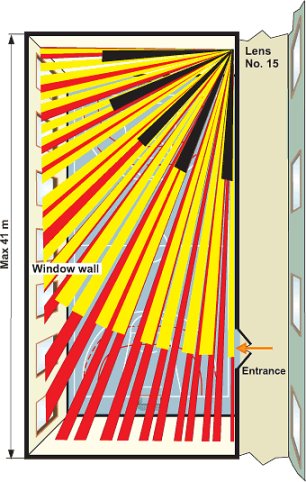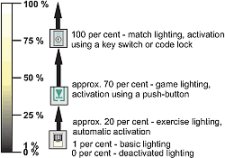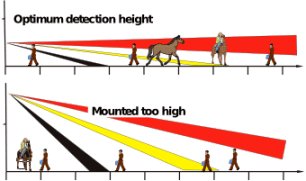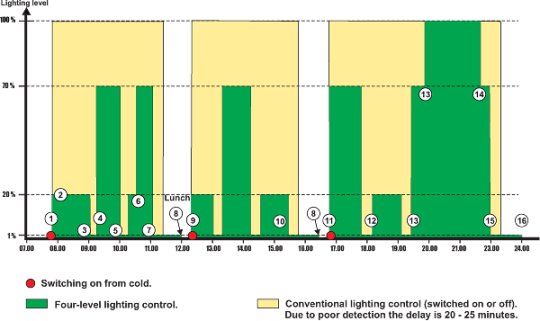5F. Sports hall with digital fittings (DSI)
IR detectors, dimmable HF operating devices and dynamic lighting control on four levels
| The premises
This example shows a sports hall used for many different types of activity, ranging from keep-fit to TV-broadcast indoor-bandy league matches. The hall has one entrance and there is no folding partition for subdivision of the hall. So that the lighting can be adapted to the various activities, an installation with four lighting levels has been installed: 0 per cent – completely switched off The required lighting levels are set in two NV-2 DSI level selectors with digital control of the fittings. Light sources The fittings in the hall have dimmable HF operating devices with digital control in accordance with the DSI standard. Positioning of detector Positioning of the detector is crucial to the function! The example below shows how the detector should be positioned. With this positioning optimum detection is achieved upon entry, and the detector does not look out through the entrance, which means the lighting does not remain switched on when someone passes by outside. The detector is positioned in the corner furthest away from the entrance at a height of 2 – 2.5 m. The mounting height is very important to reliable detection. Mounting too high up can result in relatively large areas with poor detection. Information for current budget
|
Control system
The control system in this installation works in accordance with the ‘Dynamic lighting control’ principle. The technology can be used both for acoustic control and for control using IR detectors. The wiring diagram for dynamic lighting control using IR detectors is shown on the following page. The most important advantages attained using Dynamic Control are as follows:
The installation in the example is based on two NV-2 DSI level selectors and the EX-13 logic module. Presence in the hall is detected by a PD-2200 IR detector with Lens No. 15. Upon entry into the hall the exercise lighting (20 per cent) is activated by the IR detector. If the activity in the hall requires more light, the lighting can be activated in two further stages. The game lighting is switched on by a pulse-emitting high/low push-button. Renewed pressure on the button reconnects the basic lighting. It must not be possible for just anyone to switch on the match lighting, thus this is done using a code lock, a key switch or a switch in a locked cabinet. When the presence ceases the lighting is switched down to basic lighting following the delay (5 – 7 minutes) set in the IR detector. The exercise, game and match lighting can also be switched off manually using the ‘Off’ push-button, going into dynamic rest mode. The basic lighting stays on at approx. 1 per cent light strength for about an hour a time set on the ‘Off’ potentiometer in the EX-13. If no presence is detected during this time the lighting is then completely switched off by the EX-13 breaking the feed to the contactor. See wiring example below!
|
||||||||||||||||||||||||||
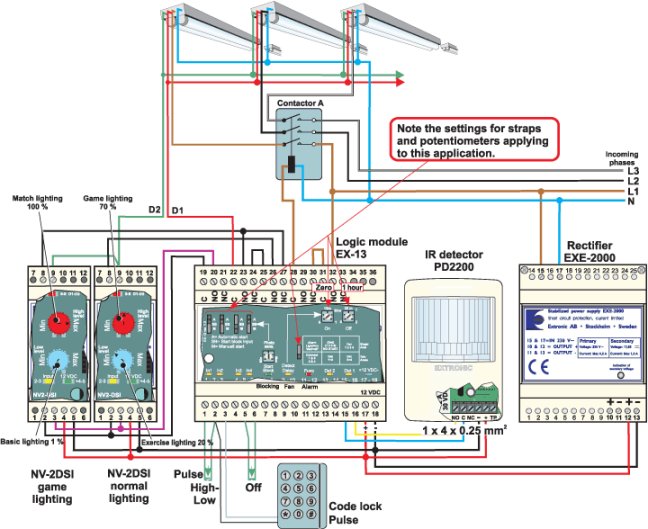
Four-level lighting control in a sports hall 0% – Switched off completely. |
|||||||||||||||||||||||||||
|
|
||||||||||||||||||||||||||
| The entire yellow area in the diagram above is unnecessary energy consumption that only benefits your electricity supplier! | |||||||||||||||||||||||||||

